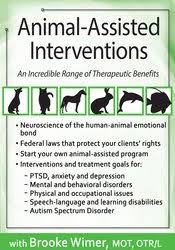You will also discover very practical information and resources to help you implement your own animal-assisted interventions.
Jonathan Jordan – Animal-Assisted Interventions
Brief Overview
Human-animal emotional bond
Therapy animal vs. service animal vs. emotional support animal
Animal-assisted therapy vs. animal-assisted activities
Handler vs. therapist
Mindfulness of Animals and How it Helps the Human Brain
The neuroscience of the human-animal bond
Why zebras don’t get ulcers
Animal-assisted interventions without an animal
The Legal Landscape
Four federal laws that impact animal-assisted interventions
Client rights and when not to involve an animal
Informed consent
Interventions and Treatment Goals
Physical and occupational issues
Fine and gross motor skills
Standing balance
Sensory processing
Mental, emotional, and behavioral disorders
PTSD, anxiety and depression
Loneliness and self-esteem
Autism spectrum disorder
Speech-Language and learning disabilities
Dyslexia and other learning difficulties
Vocabulary improvement
Increase verbal interactions
Components of Animal-Assisted Intervention
How to approach clients
Interaction techniques for client and animal
Closure, documentation
Evidence-Based Research and Outcomes
Disorders that respond well to animal-assisted interventions
Autism spectrum disorders
ADHD and related childhood educational issues
Speech and language disorders
Stroke and geriatric issues
Depression and anxiety
PTSD
Benefits of owning a companion animal
Start Your Own Animal-Assisted Program
Animal qualifications and characteristics
Preparing and caring for the animal
When the animal shows signs of stress and agitation
Organizations and resources for starting your animal-assisted program
Would you like to receive Jonathan Jordan – Animal-Assisted Interventions ?
Description:
​Neuroscience of the human-animal emotional bond
Federal laws that protect your clients’ rights
Start your own animal-assisted program
Interventions and treatment goals for:
PTSD, anxiety and depression
Mental and behavioral disorders
Physical and occupational issues
Speech-language and learning disabilities
Autistic Spectrum Disorder
This seminar is designed to help you discover how incorporating animals into your professional activities can greatly improve client outcomes in a surprisingly broad range of areas, including:
Reduce stress and anxiety levels and lower blood pressure
Lessen feelings of loneliness and depression
Help people suffering from agoraphobia
Improve sensory recognition in people recovering from a stroke
Support people dealing with trauma
Help children with learning disabilities
You will receive specific examples of animal-assisted therapeutic goals in a variety of functional areas. This seminar also includes the latest research outcomes, solid foundational knowledge about the human-animal emotional bond and up-to-date information about relevant laws. You will also discover very practical information and resources to help you implement your own animal-assisted interventions.








